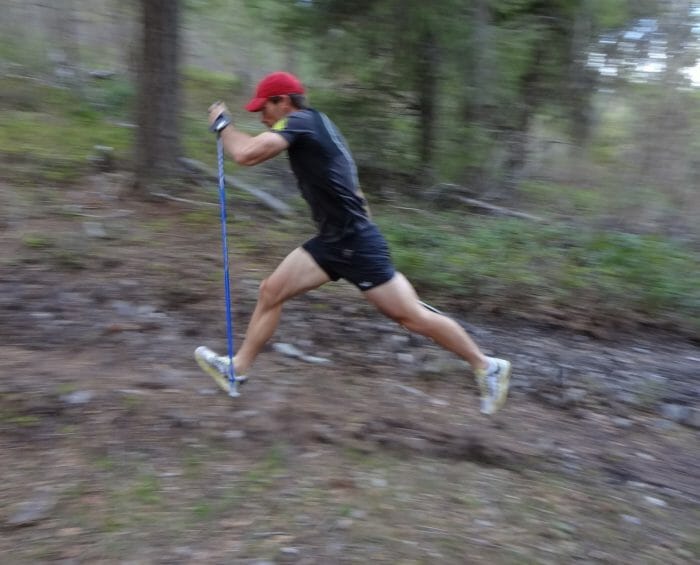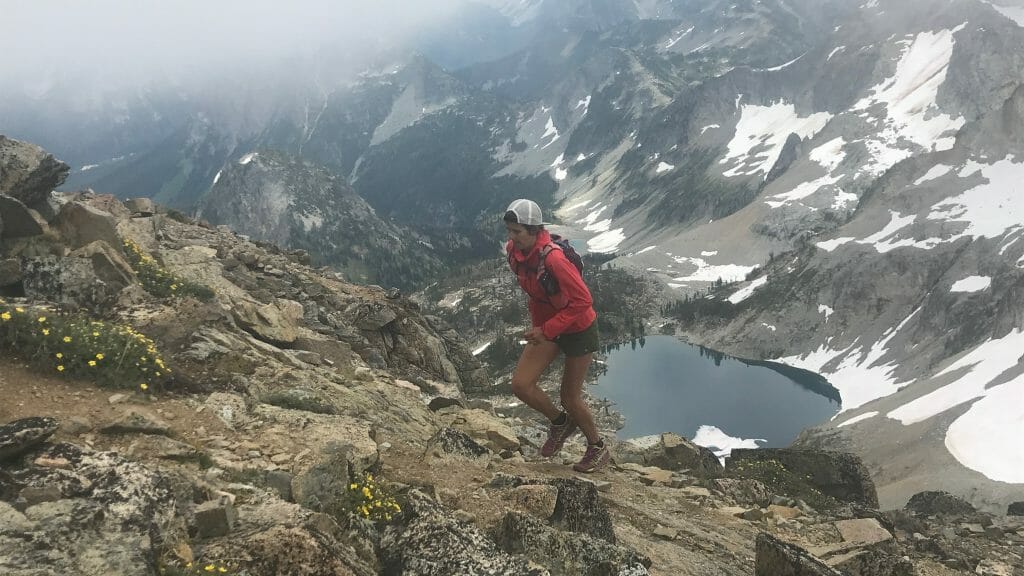Many athletes we work with throughout the year target long-duration events: high-altitude climbs, ultramarathons, and big ski tours. As avid readers of Uphill Athlete literature know, the biggest bang for these athletes’ buck will be aerobic-capacity-building training. This comes in the form of low-intensity, long-duration work—multi-hour climbs, weighted pack carries, long aerobic runs. But for others there are competitions on the horizon. The 50K ultrarunner, the skimo racer with an eye on Patrouille des Glaciers, and the road runner–turned–vertical kilometer aficionado all need to pay attention to their speed potential. To perform well, they need to be able to prolong a higher-pace output for the duration of their event. Developing this capacity means intervals. But what type? When I’m looking to build an athlete’s speed, particularly on varied terrain, I turn to 30/30 interval training.
There are myriad flavors of high-intensity interval training out there. Perhaps more than any other form of exercise (with the exception of strength training), HIIT generates extensive debate over correct protocol. None of these recipes for success are (or should be) secret, and there are only a few I employ across the spectrum of athletes I train. Interestingly, and arrived at completely independently, Kilian Jornet uses 30/30s and says they are his preferred way of introducing intensity into his training program.
My Experience with 30/30s
Scott Johnston had read about a professor of sport sciences at the University of Lille in France, Veronique Billat, who had tested several different methods of increasing an athlete’s velocity at VO2max (vVO2max). Her aim was to pinpoint the method that gave the best results with the least stress to the athlete. The optimal protocol she arrived at was 30 seconds fast, at around 90–95 percent of max speed, with a 30-second recovery interval: “30/30s.”
Lacking a reliable vVO2max pace in Nordic skiing due to the varied nature of our race terrain, we targeted around 92–95 percent of max heart rate (HR) for the “on” interval. During the equal rest portion, we’d allow HR to drop only about 5 beats per minute (bpm). The effect of this was that we’d ski at a very high speed during the on time but would not decrease our speed that much during the recovery interval. However, the perception of recovery was quite positive given the equal time on and off. In our early iterations of this workout, I recall striding up a very steep road grade on roller skis with Scott behind me in his car. He honked the horn every 30 seconds to signal the intervals.
Why 30/30 Interval Training Works
Fast-forward to present day: the 30/30 interval protocol remains an incredibly effective means of improving an athlete’s high-end speed without overly taxing them metabolically. Why? Because the 30-second on time is not long enough for the athlete to develop a high blood lactate concentration, which has the effect of decreasing power output by increasing the concentration of hydrogen ions and therefore acidity in the working muscles. Instead, the 30 seconds is just long enough for the athlete to accelerate up to a high speed, hold it for 15–20 seconds, and then decelerate into the rest. The cardiac demand stays relatively high with only around a 5 bpm decrease during the rest interval. As far as your heart is concerned, you’re working quite continuously at or near your VO2max.
The 30-second recovery interval allows the myoglobin in the muscle cell to recharge its small oxygen store. This in turn allows a higher power output—and better engagement of fast twitch muscle fibers—for the next 30-second work bout. Fast twitch fibers have poor endurance and will fatigue during longer work repetitions; the short repeats with equal rest intervals provide them with a greater endurance training effect.
Perception-wise, athletes report leaving a 30/30 interval workout feeling invigorated and not overly wiped out. This is often in stark contrast to sensations after finishing a more traditional VO2max interval workout with long-duration repeats. For the athlete in a technique-focused sport or one requiring high cadence, such as Nordic skiing, skimo, or running, these intervals allow you to maximize those efficient movements but then recover before fatigue sets in.
How to Integrate 30/30s into Your Training
The best way to incorporate 30/30 interval training into your diet is to (surprise, surprise) build them on a foundation of good aerobic base capacity and some moderate Zone 3 intensity first. This readiness varies by individual, so it can be helpful to get outside input. When you’re ready to try 30/30s, start with 1–2 sets of 8–10 minutes apiece, separating the sets with at least 5 minutes of very easy movement. Use terrain that mimics your sport requirements and prioritize precision movement—both cadence and technique—to get the most out of the intervals.
A tip to get you started: Let the first 4–5 intervals of the first set be part of your warm-up. Don’t peg the target intensity right from the start or you’ll blow up by the fifth 30/30. Instead, build gradually to the heart rate or pace you want to reach; aim to get there midway through your first set. In this manner, you’ll be able to complete the subsequent intervals and sets with greater efficiency and power.
Example 30/30 Interval Workout for Uphill Athletes

- Warm up 20 minutes easy, building to your Aerobic Threshold (AeT) on mellow terrain.
- Complete 2×2 minutes in low-to-mid Z3, approaching your Anaerobic Threshold. Take 1 minute rest between each.
- Do 2×8–10min of 30 seconds on, 30 seconds off. The “on time” should be at around 92–95 percent of your max HR. Let HR drop only about 5 bpm during the “off” interval. Build the intensity gradually so you’re not reaching the target HR until the fourth interval.
- Take 5–10 minutes easy recovery between sets.
- Cool down with 15 minutes easy (sub-AeT) movement when done.
NOTE: The real benefits of this workout come from the volume of hard work. We typically build to where an athlete is doing 1×30 minutes of 30/30s. Repeating the warning above: DON’T START TOO FAST.
Let 30/30 interval training be part of the finishing touches leading into a speed-focused event. Keep in mind the timeless words: “Speed Kills … Those Who Don’t Have It!”
This article was originally written by Sam Naney.

